Do You Lead Change?
Let’s talk about the levels of experience for change leaders; and consequently, how to round out your team.

Change Leaders are a unique breed. To an extent, they are born not made. Nevertheless, there are certain skills necessary to be successful as a change leader, which they must develop. Do you possess these skills? Do your team members possess these skills?
Additionally, there are different Change Leader experience levels; and we can develop our strengths in various skills at each level as we develop as a Change Leader.
Change Leadership is the ability to energize groups who will be implementing change projects. Constituents may not always necessarily agree with the change. It’s important for Change Leaders to understand the need for change; and demonstrate a high tolerance for ambiguity as well as a positive attitude.
Change Leadership also means defining opportunities for change; managing change initiatives smoothly by anticipating, preparing for and responding effectively to roadblocks; creating an open, receptive work environment; and involving people at all levels within the organization in the change initiative.
At higher skill levels, managing complex change involves understanding cultural dynamics; developing practical strategies to achieve the best competitive advantage for the organization; and developing the skill sets of those working on the change team.
Ambiguity – A Prerequisite
Dealing with ambiguity is the #1 foundational skill for a Change Leader. Not everyone has this capability. Sometimes that’s a good thing. Picture a quality control engineer testing tolerances on nuclear reactor components. Ambiguity could be disastrous.
Keep in mind, Change Leadership does not happen in a laboratory. Take a moment to rank your organization (collectively) on a scale of 1 to 5 regarding tolerance for ambiguity with one being no tolerance for ambiguity and five being a high tolerance for ambiguity.

Why did you pick the number on the scale you chose?
Where do you think your organization should be on the ambiguity scale for optimal performance for your markets?
Often when working with these questions, leaders tell me they desire an increased level of ambiguity tolerance in their population. They want to be more nimble. They want to move faster.
Paradoxically, the unknowns that come with increased tolerance for ambiguity are tough. While they wish their teams could better deal with ambiguity, some business units would not be successful if they were higher on the ambiguity scale. In short, it depends…
“To be a successful Change Leader, even as an entry-level team member, you must be able to handle ambiguity.
Change Leadership is an island though, no matter where your organization lives – or should live – on the ambiguity scale.
Recruit for Ambiguity Tolerance
When recruiting people for a Change Leadership role, explore the degree to which the person can operate effectively in an environment where they will experience uncertainty, unpredictability, and multiple demands, without a clear sense of the desired outcome. Create scenarios to discuss with recruits that test the ability to function in this environment – the norm when leading change.
Change Leader Experience Levels
Let’s look at five Change Leader Levels of competency on a behavioral scale starting with Level I, the most basic level of experience, and moving to Level V, the most extensive level of experience.
It’s interesting to compare where you feel you fall on the scale with where others interpret your experience level.
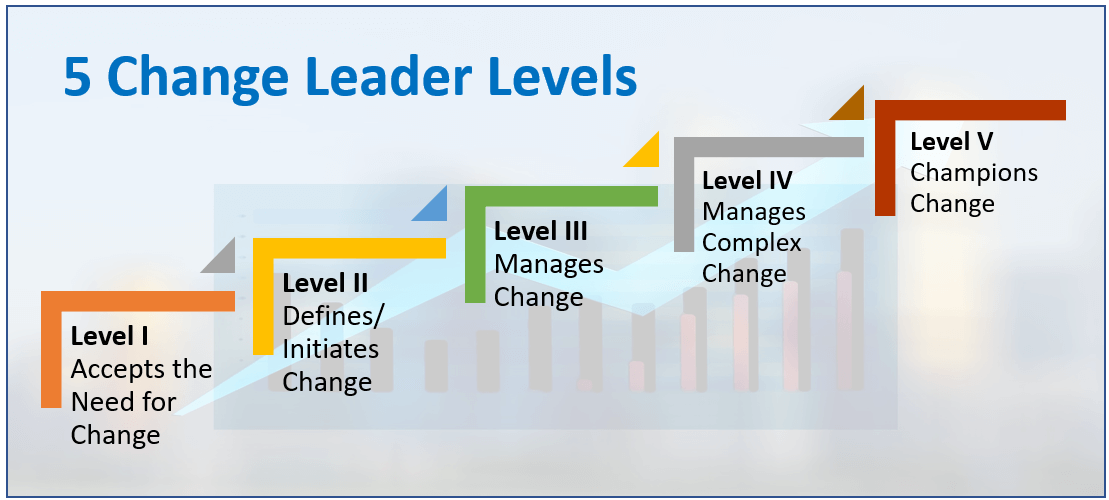
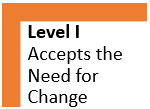
A Level I Change Leader can publicly describe a change; and persuasively defend the need for the change within the organization. This team member can tolerate ambiguity and create an open, receptive environment.
Profile of a Level I Change Leader
Mary has had experience in a specific business unit of the company and has managed a few small projects. She hopes to move into a more formal Change Leadership role for her own personal and career development. Mary has seen first-hand with her own small projects how solid Change Leadership practices enhance the organization. She lacks only experience.
To build her knowledge base and gain experience, Mary was able to study the broader organization while participating in Constituent Analysis for a large, organization-wide change initiative that directly affected her department.
During this process, Mary worked closely with the experienced Change Leader and benefited greatly from this mentor / mentee relationship while still providing value. The experienced Change Leader assigned Mary to meet with local managers to confirm team characteristics, ask questions about change impact, and assess possible resistance.
These meetings with the Change Leaders provided Mary with hands-on experience in her desired career path; and debriefs with her mentor provided tips about next steps. All told a win-win in terms of organizational efficiency, employee training, leadership development, and employee retention.
Level I Change Leaders can be successful working on small change initiatives when given clear direction and access to more experienced Change Leaders for advice and confirmation. They can also perform change leadership tasks in larger change initiatives with a mentor.
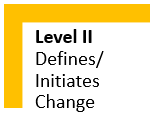
A Level II Change Leader can define a specific area where change is necessary; identify the advantage points for changes in processes and work habits; and can then initiate the specific change project.
Profile of a Level II Change Leader
Tom worked as a project manager and Change Leader in the Marketing department. He noticed sales leads were all treated the same, which caused inefficiencies; and potential lost revenue.
Tom worked with external vendors to streamline the marketing and sales automation process. He worked to activate additional functions of the software; pitched the more efficient workflow to both Marketing and Sales leadership; executed implementation with the various Marketing teams; and met with the Training and Sales departments to measure readiness and prepare training for the updated workflow.
Level II Change Leaders can identify the need, develop an approach, and initiate change at the local departmental level.
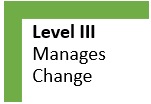
A Level III Change Leader can define an explicit approach for change based on broad organizational visions and strategic goals.
They manage the effort to deliver the new approach to all constituents; control the messaging to keep all primary and secondary constituents affected informed; and can adapt the change initiative when an organizational vision has been refined.
A Level III Change Leader can redirect individual or team approaches in the face of new growth opportunities for the organization; and involve the appropriate people across the organization in the change effort.
At this level, the Change Leader ensures the success of change through implementation of a communication strategy; the refinement of work and organizational design models; and the facilitation of staff development.
Profile of a Level III Change Leader
Martha has experience leading a variety of change initiatives at various levels within the organization. She is qualified to lead an initiative to transition the top Sales associates to an Account-Based Sales model.
This initiative is a cultural change that crosses departmental lines and involves a high level of complexity. Martha will need to execute all aspects of the organization’s change methodology. These initiatives are typically high profile, albeit within a limited area of the company.
Level III Change Leaders can translate the vision of the organization into the context of a specific change initiative; and successfully bring this message to the entire organization.
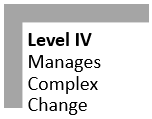
A Level IV Change Leader understands the cultural dynamics of the current state of an organization; including the hidden assumptions, as well as the differences between stated values and the values in practice.
At this level, the Change Leader can create a strategic practical course – balancing the current reality with the need for rapid adoption of the desired future reality.
Profile of a Level IV Change Leader
Alex has experience with multiple complex change initiatives that have involved the entire organization. He can create and execute the change leadership strategy for a program to implement a new ERP system throughout the global organization over multiple years.
Alex must be able to create a change process that is transferrable to each location for project implementation on a regional basis easily.
Level IV Change Leaders can manage change in a productive, encouraging way vs. a destructive, negative way.
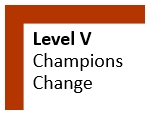
At this strategic level, a Level V Change Leader publicly challenges the status quo by comparing it to an ideal or a vision of change. This may cause a sense of crisis or imbalance within the organization.
Level V Change Leaders support dramatic actions to implement change. They are responsive to and responsible for planning evolution, causing change, and transforming the organization.
The Level V Change Leader many times comes from outside the organization. Often, a Level IV Change Leader does not endeavor to become a Level V Change Leader. The Level V Change Leader is usually a temporary or contractual resource.
It’s common for a Change Leader to maintain a Level IV position continuing to hone their own and their direct reports’ Change Leadership skill sets. In fact, they may be the person that advises senior management to employ a temporary Level V Change Leader.
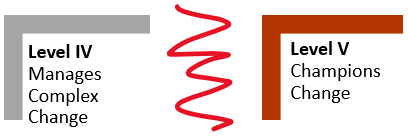
The Level V Change Leaders charge is to revolutionize the organization.
Consistency
In this article, we strove to quantify (in a basic way) the growth journey of a Change Leader. Consistency of both education and development levels is difficult. Be prepared to be creative.
For example, Constituent Hub customer organizations benefit from an extensive Change Leader Certification Program. This program trains and certifies Change Leaders at four unique but related levels.
This methodology ensures a consistent level of knowledge about using Constituent Hub features. At the same time, this approach inherently teaches the overall function, philosophy, and methodology of Change Leadership.
Typically, most organizations do not have the in-house capability to provide all the educational tools needed to develop a Change Leader. Over 68% of respondents to an online poll conducted by Transition Management Advisors seek their Change Leadership education externally.
The Change Leader competencies we teach/coach – planning, project time management, coalition building, decision making, active listening, meeting management, and communication – come into play at all experience levels of change leadership.
You can increase your competency in these skill sets. You may have to work harder to access the learning tools, but if you continue to develop these skill sets, you will be able to move up the spectrum of change leadership to become a unique Level IV or V Change Leader.

Jim Canterucci is the founder of Constituent Hub and Transition Management Advisors. He works closely with executives and their teams to implement strategy through organizational change initiatives.
Contact Jim – EMAIL or 614.783.6565.
To bring Constituent Hub to your organization, let’s talk. First, please tell us about your current Change Leadership approach. Click here for a survey that will ensure a productive conversation.
